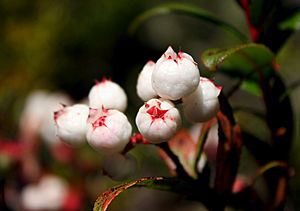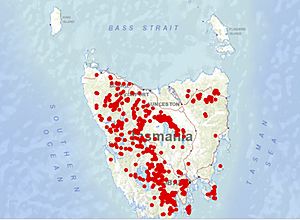Copperleaf snowberry facts for kids
The copperleaf snowberry, officially known as Gaultheria hispida, is a special plant. It grows only in Tasmania, Australia. This plant is a shrub with many branches. You can find it in wet forests and cold mountain areas. Its leaves have a copper color, and its berries look like snowy white pearls. This is how it got its common name.
Quick facts for kids Copperleaf snowberry |
|
|---|---|
 |
|
| Gaultheria hispida, Tasman Peninsula, Tasmania | |
| Scientific classification | |
| Genus: |
Gaultheria
|
| Species: |
hispida
|
Contents
What is the Copperleaf Snowberry?
Gaultheria hispida is a small, upright shrub. It belongs to the Ericaceae plant family. This family also includes plants like blueberries and rhododendrons.
How Big Does it Get?
In a protected spot, like a forest, G. hispida can grow up to 2 m (6 ft 7 in) tall. In open, windy mountain areas, it will be smaller.
What Does it Look Like?
Its leaves are dark green and shiny. They are 4–9 cm (1.6–3.5 in) long. The leaves have sunken veins and slightly jagged edges. These edges often have a copper tint. The stems are usually red. At the top of the stems, you'll find clusters of small, white, bell-shaped flowers.
When Does it Flower and Fruit?
G. hispida flowers from Spring through Summer. After flowering, it produces unique snowy white "berries". These are actually sepals (parts of the flower) that enclose a reddish fruit inside. This happens in Autumn.
Growing Copperleaf Snowberry
G. hispida is a good plant for gardens. It is easy to grow from cuttings or seeds.
Best Growing Conditions
This plant likes soil that is always moist but drains well. It prefers rich, fertile soil.
Where Does Copperleaf Snowberry Live?
The Gaultheria plant group is found in many places. You can see them in Australia, New Zealand, Asia, and North and South America.
Where is G. hispida Found?
The specific plant G. hispida grows only in Tasmania. It is also found in some parts of Victoria. In Victoria, it is considered an endangered plant. In Tasmania, it is important for conservation, but it is not rare or threatened.
Its Favorite Places to Grow
G. hispida grows best in cool, wet mountain areas. It likes elevations between 250 and 1100 meters.
It is most common in western Tasmania. This area has wet forests and mountain plants. You can also find patches of it in other mountain areas of Tasmania. These include the northeast, southeast, and central north.
How Glaciers Helped it Spread
Tasmania's history includes many ice ages. These ice ages caused mountain areas to shrink and grow. This helped plants like G. hispida spread to new places. Many of these plants then stayed in these new areas.
Other Habitats in Tasmania
G. hispida also grows in other places in Tasmania. These include rainforests, wet eucalyptus forests, and mountain vegetation.
Uses of Copperleaf Snowberry
The fruit of G. hispida can be eaten. It has a slightly bitter taste.
Traditional Food
Tasmanian Aboriginal People often collected these fruits. They used them as bushfood. Early settlers also ate them.
Other Uses of Gaultheria Plants
Other plants in the Gaultheria group have been used to make teas and jellies. Some people even believe they have natural properties that help with swelling.
Images for kids





